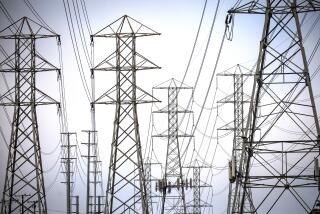Reducing Your Power Usage Will Pay Off in Future
- Share via
Go ahead. Leave a light on. The amount of money you’d save by turning off every 100-watt bulb the moment you left the room wouldn’t even buy a cappuccino in these days of budding deregulation and rising energy prices.
But if you’re convinced you it’s time to start saving money on your energy bills, it might be wise to rethink your temperature tolerance. Letting your house get a little cooler in the winter or a little warmer in the summer can save you a bundle.
“Most of our customers have air conditioning. That alone in the peak months can cost a couple hundred dollars a month to operate,” says Tony Pierce, senior engineer with Southern California Edison.
The typical household keeps the thermostat set at 72 degrees in the summertime, adds Sheree McKenna, coordinator for Edison’s in-home audit program. For every degree you hike that temperature, it saves you about 3% on the cooling portion of your energy bill, she says.
So if you raise the indoor temperature to 78 degrees in the summer, you save 18% on that portion of your bill. For a family spending $150 a month on air conditioning bills, that’s a $27 monthly saving--enough to buy several new tank tops. They’ll need them.
If you’re out of the house for most of the day, consider pushing the thermostat even higher, Pierce suggests. Although the house won’t feel quite as refreshing when you step in, for every hour that your 4-ton air conditioning unit doesn’t run, a family that’s used more than its “baseline” energy allotment will save $3.36. Over a 20-workday month, that cuts your bill by $67.
Can’t stand a blast of hot air when you walk in the door? At least close your curtains on your east- and west-facing windows, McKenna says. That will keep direct sunlight from raising the temperature so much that the air conditioner must work overtime.
When it gets cold, throw on a sweater and keep the thermostat low--between 68 and 72 degrees, experts advise. That won’t save you quite as much as it does to cut back on air conditioning, but it may save you from seeing a huge boost in your monthly gas bill.
Rate hikes for natural gas are likely to boost consumer bills from an average of $50 a month to $75, says Ron Low, a spokesman for Pacific Gas & Electric Co. So make sure you do simple things to conserve energy, such as keeping your fireplace flue closed and your windows adequately caulked. Operating the washing machine and dishwasher add up, too--but not by much. Running the dishwasher every day costs you about $11 a month. Doing 20 loads of laundry each month costs between $5 and $16, depending on whether you’ve got electric or gas appliances and whether you’re doing more cold- or hot-water washes.
Using your gas oven an hour a day, 30 days a month, costs less than $3; so does the range. You can leave the computer and color monitor on 10 hours a day every day and it’ll cost you about $5 a month. The television? Running your 27-inch TV four hours a day costs less than $2 a month. (PG&E has an energy cost calculator on its Web site at https://www.pge.com, but the rates are based on an average of 11 cents per kilowatt hour, which includes subsidized rates. Your average is likely to be a bit more--usually 1 to 3 cents more per kilowatt hour.)
Watching the energy efficiency of your appliances also makes some sense. It costs twice as much to operate a pre-1992 frost-free refrigerator than it does the comparable post-1992 model, according to PG&E. The monthly cost to operate an old 15-cubic-foot refrigerator amounts to roughly $20 each month, compared with about $10 for a newer 15-cubic-foot fridge.
Can you assume that new appliances are all more energy-efficient than the old? Unfortunately, no, Pierce says. Many less expensive appliances are cheap because they’re not energy-efficient. Anyone who knows about SEERs (seasonal energy-efficiency ratios) knows you save money when you buy cheap appliances but pay many times over when operating them.
For instance, the minimum energy-efficiency standard for an air conditioning unit is 10 SEERs, but some units boast SEER ratios of 16 or 17 and thus are 60% to 70% more efficient than the minimum. Even if you pay several hundred dollars more for the unit, you can expect it to pay for itself in decreased energy costs.
The same can be said for simple lightbulbs, Pierce notes. Though turning off the lights may not save a ton of money, it does make sense to pay attention to the type of bulb you use.
For instance, your typical incandescent lightbulb is highly energy-inefficient when compared with a compact fluorescent bulb. However, most people choose incandescent bulbs because they’re cheap, about 50 or 60 cents per 60-watt bulb. Fluorescent lights, on the other hand, might cost $8 to $12 for a bulb that generates roughly the same amount of light. But the fluorescent consumes just 13 watts of electricity and often lasts 20 times as long.
What will it save you to screw in those fluorescents instead of the incandescents? If you leave four 100-watt porch lights on for 10 hours a night, that’ll cost you 40 cents a night. Four equally bright fluorescents will cost just 10 cents a night, Pierce says. If you want those porch lights to be burning brightly 365 nights a year, fluorescents will save you nearly $110 a year.
You also might consider signing up for a time-of-use program, which varies your electric rate based on what time of day you use the power. If you can shift the bulk of your electricity use to off-peak hours--usually nights and weekends--a time-of-use plan may make sense for you. For information on a typical plan, check out the Los Angeles Department of Water and Power’s Web site at https://www.ladwp.com/resserv/conprog/timeuse/timeuse.htm.
More to Read
Inside the business of entertainment
The Wide Shot brings you news, analysis and insights on everything from streaming wars to production — and what it all means for the future.
You may occasionally receive promotional content from the Los Angeles Times.










